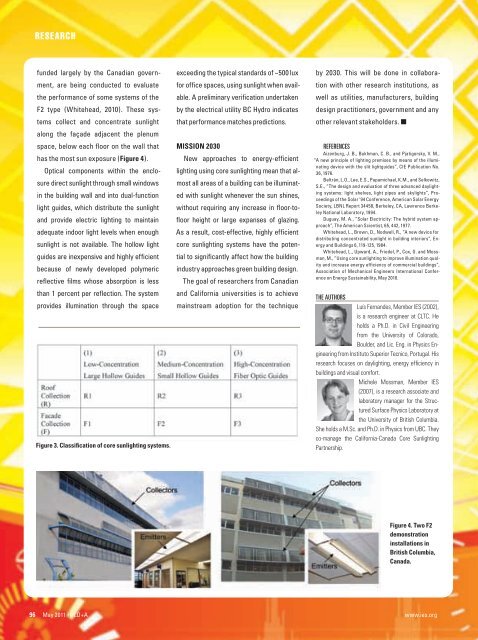May 2011 - Illuminating Engineering Society
May 2011 - Illuminating Engineering Society
May 2011 - Illuminating Engineering Society
You also want an ePaper? Increase the reach of your titles
YUMPU automatically turns print PDFs into web optimized ePapers that Google loves.
RESEARCH<br />
funded largely by the Canadian government,<br />
are being conducted to evaluate<br />
the performance of some systems of the<br />
F2 type (Whitehead, 2010). These systems<br />
collect and concentrate sunlight<br />
along the façade adjacent the plenum<br />
space, below each floor on the wall that<br />
has the most sun exposure (Figure 4).<br />
Optical components within the enclosure<br />
direct sunlight through small windows<br />
in the building wall and into dual-function<br />
light guides, which distribute the sunlight<br />
and provide electric lighting to maintain<br />
adequate indoor light levels when enough<br />
sunlight is not available. The hollow light<br />
guides are inexpensive and highly efficient<br />
because of newly developed polymeric<br />
reflective films whose absorption is less<br />
than 1 percent per reflection. The system<br />
provides illumination through the space<br />
Figure 3. Classification of core sunlighting systems.<br />
exceeding the typical standards of ~500 lux<br />
for office spaces, using sunlight when available.<br />
A preliminary verification undertaken<br />
by the electrical utility BC Hydro indicates<br />
that performance matches predictions.<br />
MISSION 2030<br />
New approaches to energy-efficient<br />
lighting using core sunlighting mean that almost<br />
all areas of a building can be illuminated<br />
with sunlight whenever the sun shines,<br />
without requiring any increase in floor-tofloor<br />
height or large expanses of glazing.<br />
As a result, cost-effective, highly efficient<br />
core sunlighting systems have the potential<br />
to significantly affect how the building<br />
industry approaches green building design.<br />
The goal of researchers from Canadian<br />
and California universities is to achieve<br />
mainstream adoption for the technique<br />
by 2030. This will be done in collaboration<br />
with other research institutions, as<br />
well as utilities, manufacturers, building<br />
design practitioners, government and any<br />
other relevant stakeholders. ■<br />
REFERENCES<br />
Aizenburg, J. B., Bukhman, C. B., and Pjatigorsky, V. M.,<br />
“A new principle of lighting premises by means of the illuminating<br />
device with the slit lightguides”, CIE Publication No.<br />
36, 1976.<br />
Beltrán, L.O., Lee, E.S., Papamichael, K.M., and Selkowitz,<br />
S.E., “The design and evaluation of three advanced daylighting<br />
systems: light shelves, light pipes and skylights”, Proceedings<br />
of the Solar ‘94 Conference, American Solar Energy<br />
<strong>Society</strong>, LBNL Report 34458, Berkeley, CA, Lawrence Berkeley<br />
National Laboratory, 1994.<br />
Duguay, M. A., “Solar Electricity: The hybrid system approach”,<br />
The American Scientist, 65, 442, 1977.<br />
Whitehead, L., Brown, D., Nodwell, R., “A new device for<br />
distributing concentrated sunlight in building interiors”, Energy<br />
and Buildings 6, 119-125, 1984.<br />
Whitehead, L., Upward, A., Friedel, P., Cox, G. and Mossman,<br />
M., “Using core sunlighting to improve illumination quality<br />
and increase energy efficiency of commercial buildings”,<br />
Association of Mechanical Engineers International Conference<br />
on Energy Sustainability, <strong>May</strong> 2010.<br />
THE AUTHORS<br />
Luís Fernandes, Member IES (2002),<br />
is a research engineer at CLTC. He<br />
holds a Ph.D. in Civil <strong>Engineering</strong><br />
from the University of Colorado,<br />
Boulder, and Lic. Eng. in Physics <strong>Engineering</strong><br />
from Instituto Superior Tecnico, Portugal. His<br />
research focuses on daylighting, energy efficiency in<br />
buildings and visual comfort.<br />
Michele Mossman, Member IES<br />
(2007), is a research associate and<br />
laboratory manager for the Structured<br />
Surface Physics Laboratory at<br />
the University of British Columbia.<br />
She holds a M.Sc. and Ph.D. in Physics from UBC. They<br />
co-manage the California-Canada Core Sunlighting<br />
Partnership.<br />
Figure 4. Two F2<br />
demonstration<br />
installations in<br />
British Columbia,<br />
Canada.<br />
96 <strong>May</strong> <strong>2011</strong> | LD+A www.ies.org

















